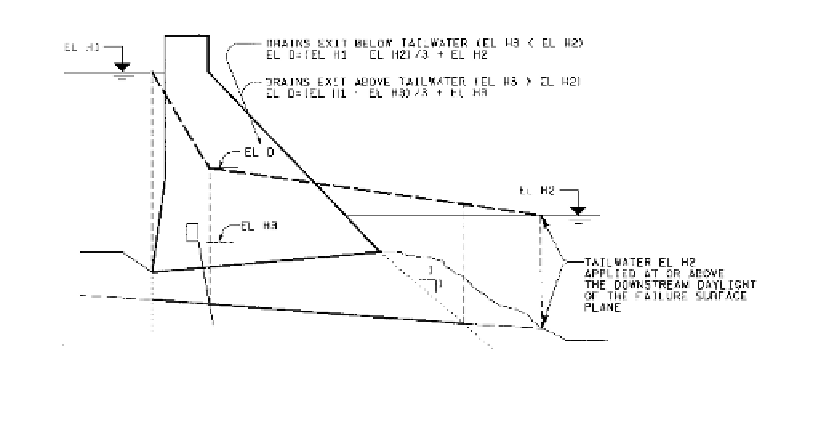Environmental Engineering Reference
In-Depth Information
Figure 16.22.
Example of uplift distribution on a discontinuity in the dam foundation (BC Hydro,
1995).
and for H4
TW
H4
K (HW
TW)
TW
(16.24)
For the no drains case (or drains blocked), the usual assumption is for 100% of the reser-
voir head at the upstream face (heel), 100% of the tailwater head at the downstream face
(toe) and for a straight line between the heel and toe.
A common assumption (e.g. ANCOLD, 1991; BC Hydro, 1995) for the case with a
well constructed and maintained borehole drain system extending deep into the founda-
tion below any potential failure surface, is for the drain efficiency (E) to be 67%; (or
K
0.33). FERC (2000) do not suggest this, recommending that the efficiency must be
measured by piezometer in the dam foundation. They point out that the measured drain
efficiency must only be considered valid for the reservoir water levels for which measure-
ments are taken, and warn that linear extrapolation to higher levels may not be valid. This
is also emphasized by EPRI (1992) who give a number of examples of non-linear uplift
response to reservoir level. The authors agree with this.
FERC (2000), US Corps of Engineers (1995) and USBR recommend use of full reservoir
head in the non-compressive zone upstream of the drains. They assume that the drains
become ineffective, and the pressures vary linearly from full reservoir head at the down-
stream end of the crack to the downstream toe head as it is assumed the drains may be
unable to relieve the pressure under this condition.
Figure 16.22 shows an example of the uplift distribution on a discontinuity in the dam
foundation.
Note that the tailwater level pressure applies where the potential failure surface emerges into
the tailwater, and the pressure at the drains is where they intersect the potential failure surface.
16.6.2
Some additional information on uplift pressures
16.6.2.1
Effects of geological features and deformations on foundation uplift
pressures
EPRI (1992) present a summary of the influence of geological features and deformations
on foundation uplift pressures. They demonstrate that the assumption of linear uplift
pressure distributions from the reservoir to tailwater for the no drains case, and from the
drains to the tailwater in the drained case, are potentially not conservative because the


